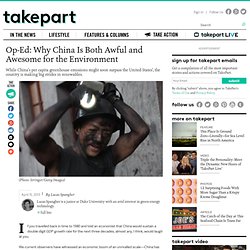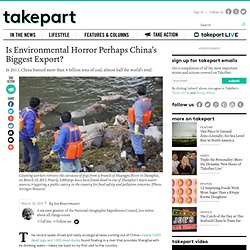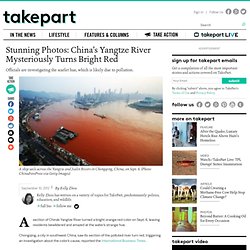

Op-Ed: Why China Is Both Awful and Awesome for the Environment. If you travelled back in time to 1980 and told an economist that China would sustain a double digit GDP growth rate for the next three decades, almost any, I think, would laugh at you.

We current observers have witnessed an economic boom of an unrivalled scale—China has hit the 40 percent urbanization mark just 22 years after the start of its industrialization, a feat that took the United States 80 years and Great Britain 120. Currently, the U.S. has nine cities with populations above one million; China has 160. Let’s consider the environmental toll of that many people. In 2000, China’s total energy consumption was half of ours. Nine years later, in 2009, China’s overall energy consumption passed America’s.
Indeed, China’s coal consumption is on pace to literally match that of the entire world. That China’s coal consumption is the “scariest fact in the world” comes almost naturally to us, but should it? Chine: une pollution au cadmium fait des ravages dans un village. Une ambulance chinoise © AFP/Archives Liu Jin Pékin (AFP) – Au moins 26 personnes sont mortes d’empoisonnement et des centaines sont tombées grièvement malades depuis 2009 en raison d’une pollution au cadmium autour d’une usine désaffectée en Chine centrale, a rapporté mercredi un média officiel.

Des échantillons de terre provenant du village de Shangqiao, dans la province du Hunan, contenaient des niveaux de cadmium jusqu’à 300 fois supérieurs aux seuils autorisés, et des concentrations excessives de ce métal hautement toxique ont été trouvées dans 500 des 3.000 habitants testés par les autorités, a indiqué le Quotidien de la Jeunesse chinoise. Selon le journal, 26 personnes sont décédées au cours des quatre dernières années en raison de leur exposition au cadmium — 20 d’entre elles sont mortes d’un cancer –, tandis que nombre d’enfants dans le village sont nés avec des malformations. Chine. Is Environmental Sin Perhaps China's Biggest Export? The recent spate of sad and nasty ecological news coming out of China—nearly 3,000 dead pigs and 1,000 dead ducks found floating in a river that provides Shanghai with its drinking water—takes me back to my first visit to the country.

The West has done a very good job of exporting by example its own energy-sucking lifestyle, which is now deemed desirable by the burgeoning middle class in China. The first time I was in western China, exploring a tributary of the Yangtze River, we got badly lost and ended up on a winding road leading through landscapes I’m sure the Chinese government that had given us the permit never intended for us to see. All around forests were clear-cut, paper plants were built on rivers above towns, children with deformities were visible in outsized numbers on the streets, and the air was so hazy at midday that many people wore medical masks, even indoors. That was in 1996. China today—like the other fast-growing mega-nations, especially India—is obsessed with growth. Emissions de Gaz à effet de serre. Yangtze River in China Mysteriously Turns Bright Red, Leaves Residents Confused. A section of China’s Yangtze River turned a bright orange-red color on Sept. 6, leaving residents bewildered and amazed at the water’s strange hue.

Chongqing, a city in southwest China, saw its section of the polluted river turn red, triggering an investigation about the color’s cause, reported the International Business Times. MORE: Endangered Animals, Toxins, and Heavy Metals Found in Chinese Medicines The Daily Telegraph reported that the scarlet color may be due to “industrial pollution in silt churned up by recent floods,” according to Chinese officials.
The Yangtze River, the longest one in Asia and the third longest in the world, is a significant part of China’s economy—but its waters suffer from industrial pollution. The Yangtze basin contributes nearly half of the country’s crop production and is the major waterway of China. Officals have good reason to suspect a chemical culprit in red-river mystery. Scroll below for more photos of Chongqing's scarlet river.